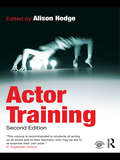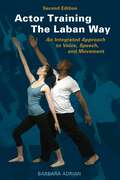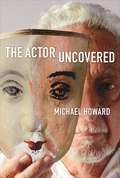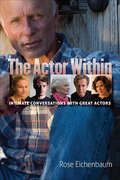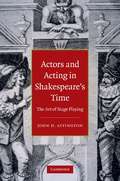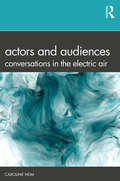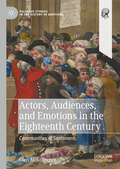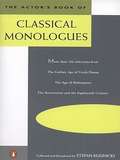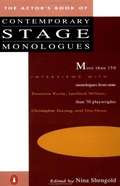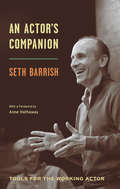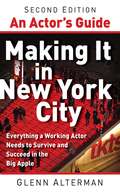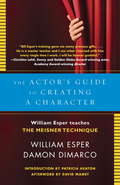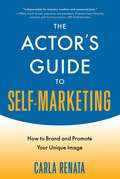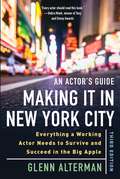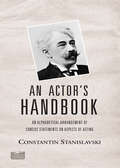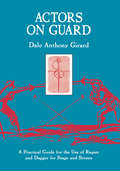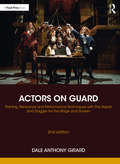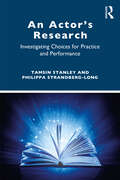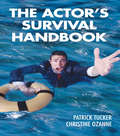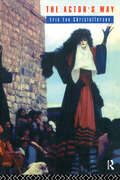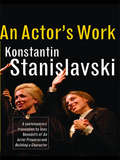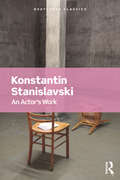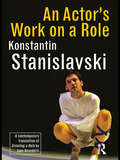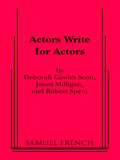- Table View
- List View
Actor Training
by Alison HodgeActor Training expands on Alison Hodge's highly-acclaimed and best-selling Twentieth Century Actor Training. This exciting second edition radically updates the original book making it even more valuable for any student of the history and practice of actor training. The bibliography is brought right up to date and many chapters are revised. In addition, eight more practitioners are included - and forty more photographs - to create a stunningly comprehensive study. The practitioners included are: Stella Adler; Eugenio Barba; Augusto Boal; Anne Bogart; Bertolt Brecht; Peter Brook; Michael Chekhov; Joseph Chaikin; Jacques Copeau; Philippe Gaulier; Jerzy Grotowski; Maria Knebel; Jacques Lecoq; Joan Littlewood; Sanford Meisner; Vsevolod Meyerhold; Ariane Mnouchkine; Monika Pagneux; Michel Saint-Denis; Włodzimierz Staniewski; Konstantin Stanislavsky; Lee Strasberg The historical, cultural and political context of each practitioner's work is clearly set out by leading experts and accompanied by an incisive and enlightening analysis of the main principles of their training, practical exercises and key productions. This book is an invaluable introduction to the principles and practice of actor training and its role in shaping modern theatre.
Actor Training the Laban Way (Second Edition): An Integrated Approach to Voice, Speech, and Movement
by Barbara AdrianThe Groundbreaking Actor Training Guide, Enhanced with New Videos and Expert Advice from Acting Professionals Actors, teachers, and students of performing arts: sharpen your skills and release your potential with Actor Training the Laban Way, a groundbreaking approach to physical and vocal movement. Utilizing theories of preeminent movement theorist Rudolf Laban, acting teacher and performer Barbara Adrian integrates voice, speech, and movement training with illustrated individual and group exercises that include: Breath Support Building Dynamic Alignment Expanding Vocal Tone and Range Articulation and Rhythmic Exploration Enhancing Strength and Stamina Improving Balance and Flexibility Developing a Relationship to the Environs Revealing Your Emotional State through Physical and Vocal Action This second edition also includes an all-new chapter of advice from acting professionals on how they deploy these exercises and techniques in their acting preparation, practice, and performance. New appendices offer readers links to video supplements as well as exercises in IPA.Actor Training the Laban Way will make any performer more impulsive, imaginative, and expressive.
The Actor Uncovered
by Michael HowardA Far-Reaching and Truthful Exploration of Acting in All Its FormsThe Actor Uncovered is certainly not a set of rigid rules advocating one "method" or one singular "truth." Departing from the common guidebook format, Michael Howard uses a unique approach to teaching acting, reflecting on his own history and sharing his own experiences as an actor, director, and teacher. How he writes about the process and craft of acting is at once intensely personal and relatable by others.Readers are invited to participate as though present in this master teacher's classes. Each human being, and thus each actor, is unique. Howard encourages actors to uncover their own ways of working, using their particular abilities and personality traits. Going beyond the craft and into human psychology and the importance of acting as a life force, readers will see new and deeper ways to study and practice, to be introspective, and to arrive at places of revelation about their craft.The Actor Uncovered will have much to say to beginners, to those who are advanced, and to professional and working actors. Howard discusses such topics as:Techniques, styles, and methods in a changing societyRelaxation, concentration, and the breathThe relationships among actor, director, and writerMemoryOn camera versus on stageObstaclesAfter more than seventy years as a professional actor, director, and teacher, Howard shows how living creatively and invoking one's own personality can lead to a successful career as an actor.
The Actor Within: Intimate Conversations with Great Actors
by Rose EichenbaumIn Rose Eichenbaum's third work on the confluence of art making and human expression, she delves into the lives of thirty-five celebrated actors through intimate conversations and photographic portraits. With her probing questions and disarming manner, she captures the essential character of her subjects while shining a light on the art that defines them. The work provides extraordinary insights on the craft of acting with discussions of process, techniques, tools of the trade, and how to advice for aspiring actors from seasoned veterans. These stars of stage and screen, known for signature roles and critically acclaimed performances, emerge in The Actor Within with masks and wardrobe removed. Here, they speak their own lines, tell their own stories, and raise the curtain on what it means to live the actor's life—the challenge of mastering their craft, the drama of big breaks and career woes, the search for meaningful roles, and above all, having the courage to bare their souls before theater audiences or the camera. For the artists featured in this work, acting is more than a profession; it is how they make their way in the world and artfully merge their inner sense of humanness with universal truths. This collection serves as an important inspirational resource for anyone interested in making art, regardless of medium.The Actor Within includes interviews with Karl Malden, Ruby Dee, Ed Harris, Piper Laurie, Marcia Gay Harden, William H. Macy, Ellen Burstyn, Joe Mantegna, Debra Winger, Julia Stiles, Elliott Gould, Elijah Wood, Stockard Channing, Bill Pullman, Amanda Plummer, Marlee Matlin, Charles Durning, Marsha Mason, and many others.
Actors and Acting in Shakespeare's Time
by John H. AstingtonJohn Astington brings the acting style of the Shakespearean period to life, describing and analysing the art of the player in the English professional theatre between Richard Tarlton and Thomas Betterton. The book pays close attention to the cultural context of stage playing, the critical language used about it, and the kinds of training and professional practice employed in the theatre at various times over the course of roughly one hundred years - 1558-1660. Perfect for courses, this 2010 survey takes into account recent discoveries about actors and their social networks, about apprenticeship and company affiliations, and about playing outside the major centre of theatre, London. Astington considers the educational tradition of playing, in schools, universities, legal inns, and choral communities, in comparison to the work of the professional players. A comprehensive biographical dictionary of all major professional players of the Shakespearean period is included as a handy reference guide.
Actors and Audiences: Conversations in the Electric Air
by Caroline HeimActors and Audiences explores the exchanges between those on and off the stage that fill the atmosphere with energy and vitality. Caroline Heim utilises the concept of "electric air" to describe this phenomenon and discuss the charge of emotional electricity that heightens the audience’s senses in the theatre. In order to understand this electric air, Heim draws from in-depth interviews with 79 professional audience members and 22 international stage and screen actors in the United Kingdom, United States, France and Germany. Tapping into the growing interest in empirical studies of the audience, this book documents experiences from three productions – The Encounter, Heisenberg and Hunger. Peer Gynt – to describe the nature of these conversations. The interviews disclose essential elements: transference, identification, projection, double consciousness, presence, stage fright and the suspension of disbelief. Ultimately Heim reveals that the heart of theatre is the relationship between those on- and off-stage, the way in which emotions and words create psychological conversations that pass through the fourth wall into an "in-between space," and the resulting electric air. A fascinating introduction to a unique subject, this book provides a close examination of actor and audience perspectives, which is essential reading for students and academics of Theatre, Performance and Audience Studies.
Actors, Audiences, and Emotions in the Eighteenth Century: Communities of Sentiment (Palgrave Studies in the History of Emotions)
by Glen McGillivrayThis book offers an innovative account of how audiences and actors emotionally interacted in the English theatre during the middle decades of the eighteenth century, a period bookended by two of its stars: David Garrick and Sarah Siddons. Drawing upon recent scholarship on the history of emotions, it uses practice theory to challenge the view that emotional interactions between actors and audiences were governed by empathy. It carefully works through how actors communicated emotions through their voices, faces and gestures, how audiences appraised these performances, and mobilised and regulated their own emotional responses. Crucially, this book reveals how theatre spaces mediated the emotional practices of audiences and actors alike. It examines how their public and frequently political interactions were enabled by these spaces.
The Actor's Book of Classical Monologues
by VariousA challenging, wide-ranging collection of monologues from history’s greatest dramatic works. From the stately and poetic Greek tragedies to the lively, bawdy Restoration comedies, the classical repertoire is a treasure trove of often-overlooked materials for male and female, young and old. The solo pieces collected here vary widely in mood, style, and level of challenge; they include a generous supply of Shakespeare and his contemporaries; and they’re fleshed out with brief plot synopses and valuable historical material. Stefan Rudnicki, an accomplished actor, director, and teacher, also provides practical tips on preparing each scene for audition or performance. Among the playwrights whose works are included are: Aeschylus Sophocles Euridipes Aristophanes Shakespeare Tourneur Kyd Middleton Jonson Sheridan Dryden Congreve …and many others.
The Actor's Book Of Contemporary Stage Monologues: More Than 150 Monologues From More Than 70 Playwrights
by Nina Shengold Smith Kraus Inc. StaffThis is the only book that offers a comprehensive collection of contemporary stage monologues for a complete range of roles. An invaluable tool for actors looking for new audition material or for anyone interested in theater.
An Actor's Companion
by Seth Barrish Anne Hathaway"I was totally unprepared for the transformation that Seth's technique created in me. . . . I realized that what I thought I knew about acting up to that point was largely misguided . . . but I now had a great, talented, dedicated teacher who generously wanted to share his tools with everyone. There is muscularity, not to mention wisdom and truth to Seth's techniques. He is a wonderful teacher, and I know that having him as my first guide is one of the luckiest things to have happened to me in my career and life. And when I can't get back to class with him, I am so grateful I have this book to turn to."--Anne Hathaway"This book is truly unlike anything else I know--these pieces are haikus on specific elements of performance and character building."--Philip Himberg, executive director, Sundance Theatre InstituteA collection of practical acting tips, tools, and exercises, An Actor's Companion is ideal for both the seasoned professionals and actors-in-training. The tips--all simple, direct, and useful--are easy to understand and even easier to apply, in both rehearsal and in performance.Seth Barrish is an actor, teacher, and the co-artistic director of The Barrow Group in New York City. In his thirty-year career, he has directed the award-winning shows My Girlfriend's Boyfriend (Lucille Lortel Award for Best Solo Show, Drama Desk and Outer Critics Circle nominations for Best Solo Show), Sleepwalk With Me (Nightlife Award for Outstanding Comedian in a Major Performance), The Tricky Part (Obie Award, Drama Desk nominations for Best Play and Best Solo Show), Pentecost (Drama Desk nomination for Best Play), Old Wicked Songs (Los Angeles Drama Critics Circle Award and Garland Award for Best Direction), and Good (Straw Hat Award for Best Direction), among dozens of others.
An Actor's Guide--Making It in New York City: Everything a Working Actor Needs to Survive and Succeed in the Big Apple
by Glenn AltermanFor any actor in or on the way to New York City, this is the definitive source for advice, winning strategies, marketing techniques, and invaluable insights to being a successful New York actor. This new edition has been completely revised and updated to cover the significant changes in the New York theater landscape over the last nine years. This indispensable guide has also been expanded to include dozens of new interviews with top New York City actors and a completely improved Internet chapter equipped with the most up-to-date tools to thrive in the industry. Aspiring and established professionals will find this thorough and up-to-the-minute volume chock full of resources and advice about auditioning, making professional connections, promoting one's self, seeking opportunities in nontraditional venues, finding an apartment, securing "survival jobs," understanding actor unions, getting headshots, and furthering one's actor training in New York. This guide also details working as a film extra, careers in print modeling, scams and rip-offs to avoid, opportunities for actors with disabilities, and using the Internet to the fullest advantage. Included are in-depth interviews with legendary show business figures such as actor Henry Winkler, casting director Juliet Taylor, and theater director Joseph Chaikin as well as top talents from the fields of film, television, stage, commercials, and talent agencies. Written by a professional New York actor with over thirty years of experience, this meticulously researched guide will give actors the tools they need to survive and thrive in New York show business.
The Actor's Guide to Creating a Character: William Esper Teaches the Meisner Technique
by David Mamet Patricia Heaton William Esper Damon DimarcoWilliam Esper, one of the most celebrated acting teachers of our time, takes us through his step-by-step approach to the central challenge of advanced acting work: creating and playing a character. Esper's first book, The Actor's Art and Craft, earned praise for describing the basics taught in his famous first-year acting class. The Actor's Guide to Creating a Character continues the journey. In these pages, co-author Damon DiMarco vividly re-creates Esper's second-year course, again through the experiences of a fictional class. Esper's training builds on Sanford Meisner's legendary exercises, a world-renowned technique that Esper further developed through his long association with Meisner and the decades he has spent training a host of distinguished actors. His approach is flexible enough to apply to any role, helping actors to create characters with truthful and compelling inner lives.
The Actor's Guide to Self-Marketing: How to Brand and Promote Your Unique Image
by Carla RenataStand Out from the Competition! How do actors sell their personality? What does it take to make a lasting impression? How can actors use their image to achieve their dreams? The Actor's Guide to Self-Marketing answers all these questions and more. With a background in acting and publicity, author Carla Renata has gathered insider info and proven tips to help actors create their own brand and utilize it for success. With The Actor's Guide to Self-Marketing, you will learn how to: Highlight unique traits and skills Distinguish yourself from the crowd Market yourself through social media Angle for your dream role And so much more! Renata's methods have been tested and developed through her branding and social media program, The Branding Buddha, which has been taught online and privately, as well as in group classes at top universities in the United States. Along with tips from her program and extensive background in the field, Renata uses meditative practices and self-actualization to help actors develop their public image and reach their goals with clarity and intention. As she writes, "The mind is everything. What you think, you will become." With The Actor's Guide to Self-Marketing, you'll be well on your way to becoming the actor you really want to be and landing your dream roles.
An Actor's Guide—Making It in New York City, Third Edition: Everything a Working Actor Needs to Survive and Succeed in the Big Apple
by Glenn AltermanA Step-by-Step Guide for the Actor Pursuing a Career in New York A great deal has changed in the industry in the last decade. In this new, third edition of An Actor&’s Guide—Making It in New York City, Glenn Alterman provides everything actors need to know. You&’ll discover the ten things that it takes to make it as a successful actor in the city, how to support yourself, where and how to start your life as a New York actor, understanding and marketing &“your brand,&” the best acting schools and conservatories, effective ways to contact agents and casting directors, and more. The author, a successful working actor, also shares many insider tips on topics such as: how to network effectivelyheadshots, photographers, and how to have a successful photo sessioncreating your actor websitesthe best Internet resources and casting siteshow to give winning auditions and interviewsfinding and developing great monologuesoff and off-off Broadway opportunitiesTV and film opportunitiesvoice-overscommercial print modelingcommercialssurvival jobsappropriate behavior in the businessscams and rip-offs to avoidinformation for actors with disabilitiesinformation on diversity and LGBTQ concernsa listing of agents, casting directors and theaters Among the book&’s many interviews are legendary show business figures, such as actors Henry Winkler, Alison Fraser, Dylan Baker, Lisa Emery, and Charles Busch, as well as casting directors Juliet Taylor, Ellen Lewis, Jay Binder, Donna DeSeta, and Liz Lewis, among many others. With Alterman&’s essential guide, you&’ll be prepared to launch and maintain your dream career in the city that never sleeps.
An Actor's Handbook: An Alphabetical Arrangement of Concise Statements on Aspects of Acting, Reissue of first edition
by Constantin Stanislavski Elizabeth Reynolds HapgoodThis is the classic lexicon of Stanislavski's most important concepts, all in the master's own words. Upon its publication in 1963, An Actor's Handbook quickly established itself as an essential guide for actors and directors. Culling key passages from Stanislavski's vast output, this book covers more than one hundred and fifty key concepts, among them 'Improvisation', 'External Technique', 'Magic If', 'Imaginary Objects', 'Discipline', 'What Is My System?' and 'Stage Fright'.This reissued, attractively packaged edition will be an essential book for any performer.
Actors on Guard: A Practical Guide for the Use of the Rapier and Dagger for Stage and Screen
by Dale Anthony GirardActors on Guard is the most comprehensive and detailed book on the art of theatrical swordplay available today. It provides the reader with the historical, theoretical and practical basis for learning, practicing and presenting theatrical sword fights. Focusing specifically on the Elizabethan rapier and dagger (the most popular weapons used in stage fights), Actors on Guard provides actors, directors, teachers, stage managers and technicians the skills and knowledge essential to presenting safe and effective fights, both for stage and screen.
Actors on Guard: Training, Rehearsal and Performance Techniques with the Rapier and Dagger for the Stage and Screen
by Dale Anthony GirardActors on Guard, Second Edition is the most comprehensive book covering the current practices in learning, rehearsing and performing safe and dynamic swordfights with the single rapier and the rapier and dagger for both stage and screen. Focusing specifically on the Elizabethan rapier and dagger – the most popular weapons used in stage fights – Actors on Guard provides actors, directors, teachers, stage managers and technicians the skills and knowledge essential to presenting safe and effective swordfights. The book takes the reader through the complex process of selecting safe stage weapons, learning the basic handling and management of the rapier and dagger, as well as how to safely move and interact in the potentially dangerous process of learning, rehearsing and performing choreographed swordplay. This new edition has been revised with current industry practices, featuring hundreds of step-by-step practical exercises in the care and handling of prop swords, footwork, guards, parries, cutting and thrusting techniques, blade taking actions, disarms, wounds and kills using the rapier and dagger, with revised diagrams and photographs. An excellent sourcebook for university stage combat classes as well as self-learners, Actors on Guard provides the reader with the historical, theoretical and practical basis for mastering the art of sword fighting for the stage and screen. The book includes access to a wealth of online resources, with additional information that expands upon specific mechanics, techniques and concepts covered in the text as well as some video demonstrations of solo and partnered techniques and exercises.
Actors on Guard: Training, Rehearsal and Performance Techniques with the Rapier and Dagger for the Stage and Screen
by Dale Anthony GirardActors on Guard, Second Edition is the most comprehensive book covering the current practices in learning, rehearsing and performing safe and dynamic swordfights with the single rapier and the rapier and dagger for both stage and screen.Focusing specifically on the Elizabethan rapier and dagger – the most popular weapons used in stage fights – Actors on Guard provides actors, directors, teachers, stage managers and technicians the skills and knowledge essential to presenting safe and effective swordfights. The book takes the reader through the complex process of selecting safe stage weapons, learning the basic handling and management of the rapier and dagger, as well as how to safely move and interact in the potentially dangerous process of learning, rehearsing and performing choreographed swordplay. This new edition has been revised with current industry practices, featuring hundreds of step-by-step practical exercises in the care and handling of prop swords, footwork, guards, parries, cutting and thrusting techniques, blade taking actions, disarms, wounds and kills using the rapier and dagger, with revised diagrams and photographs.An excellent sourcebook for university stage combat classes as well as self-learners, Actors on Guard provides the reader with the historical, theoretical and practical basis for mastering the art of sword fighting for the stage and screen.The book includes access to a wealth of online resources, with additional information that expands upon specific mechanics, techniques and concepts covered in the text as well as some video demonstrations of solo and partnered techniques and exercises.
An Actor’s Research: Investigating Choices for Practice and Performance
by Tamsin Stanley Philippa Strandberg-LongAn Actor’s Research: Investigating Choices for Practice and Performance presents an accessible and highly practical guide to the research approaches required of the actor. It aims to establish the precision and rigour of the actor’s craft that is intrinsic to a compelling acting performance, explore a range of research activities surrounding and emerging from practical work in the studio, and enable the actor to evolve a multifaceted skillset in researching for performance. The chapters focus on different research areas such as the self, character, relationships, circumstance, and context, providing accessible and practical guidance to developing a personal research practice. Each aspect is explained and engaged with as practice, rather than study – offering helpful hints and advising against common pitfalls – ultimately enabling the actor to locate the necessary knowledge to shape and inform their performance in both text-based and devised scenarios. Additionally, as the actor’s self is a personal instrument that is drawn on in terms of expression, impulses, and imagination; the self also becomes a source for creative appraisal and research. This book therefore offers comprehensive advice and strategies for self-evaluation and reflection, connecting research investigation with self-exploration in making expressive performance choices, making it a practice highly applicable to the actor’s needs. An Actor’s Research closely follows the training actor’s needs in terms of performance-based research; however, its practical research activities for text and character creation and strategies for the development of critical thinking and self-reflective skills support the ongoing development of the actor and their craft in both training and professional circumstances.
The Actor's Survival Handbook
by Patrick Tucker Christine OzanneWorried about short rehearsal time? Think that fluffing your lines will be the end of your career? Are you afraid you'll be typecast? Is there such a thing as acting too much? How should a stage actor adjust performance for a camera? And how should an actor behave backstage?The Actor's Survival Handbook gives you answers to all these questions and many more. Written with verve and humor, this utterly essential tool speaks to every actor's deepest concerns. Drawing upon their years of experience on stage, backstage, and with the camera, Patrick Tucker and Christine Ozanne offer forthright advice on topics from breathing to props, commitment to learning lines, audience response to simply landing the job in the first place. The book is rich with examples - both technical and inspirational. And because a director and an actor won't always agree, the two writers sometimes even offer alternative responses to a dilemma, giving the reader both an actor's take and a director's take on a particular point.Like Patrick Tucker's Secrets of Screen Acting, this new book is written with wit and passion, conveying the authors' powerful conviction that success is within every actor's grasp.
The Actor's Way
by Erik Exe ChristoffersenCan 'stage presence' be acquired? Why do some actors appear more dynamic in performance than others? In The Actors Way four experienced actors talk about the secrets and the practical realities of over twenty-five years of theatre training with Odin Teatret. Under the unique direction of Eugenio Barba, director of Odin Teatret, they have explored issues such as the connections between physical and mental work on stage, how to gain and control the spectator's attention, and intercultural performance techniques. The Actor's Way is a fascinating account of personal and professional development in the theatre. It will be vital reading for drama students and actors, but enjoyable and illuminating for anyone interested in the craft of acting.
An Actor's Work: A Student's Diary
by Konstantin StanislavskiStanislavski’s ‘system’ has dominated actor-training in the West since his writings were first translated into English in the 1920s and 30s. His systematic attempt to outline a psycho-physical technique for acting single-handedly revolutionized standards of acting in the theatre. Until now, readers and students have had to contend with inaccurate, misleading and difficult-to-read English-language versions. Some of the mistranslations have resulted in profound distortions in the way his system has been interpreted and taught. At last, Jean Benedetti has succeeded in translating Stanislavski’s huge manual into a lively, fascinating and accurate text in English. He has remained faithful to the author's original intentions, putting the two books previously known as An Actor Prepares and Building A Character back together into one volume, and in a colloquial and readable style for today's actors. The result is a major contribution to the theatre, and a service to one of the great innovators of the twentieth century.
An Actor's Work: A Student's Diary (Routledge Classics)
by Konstantin StanislavskiStanislavski’s ‘system’ has dominated actor-training in the West since his writings were first translated into English in the 1920s and 30s. His systematic attempt to outline a psycho-physical technique for acting single-handedly revolutionized standards of acting in the theatre. Until now, readers and students have had to contend with inaccurate, misleading and difficult-to-read English-language versions. Some of the mistranslations have resulted in profound distortions in the way his system has been interpreted and taught. At last, Jean Benedetti has succeeded in translating Stanislavski’s huge manual into a lively, fascinating and accurate text in English. He has remained faithful to the author's original intentions, putting the two books previously known as An Actor Prepares and Building A Character back together into one volume, and in a colloquial and readable style for today's actors. The result is a major contribution to the theatre, and a service to one of the great innovators of the twentieth century. This Routledge Classics edition includes a new Foreword by the director Richard Eyre.
An Actor's Work on a Role
by Konstantin StanislavskiAn Actor’s Work on a Role is Konstantin Stanislavski’s exploration of the rehearsal process, applying the techniques of his seminal actor training system to the task of bringing truth to one’s chosen role. Originally published over half a century ago as Creating a Role, this book was the third in a planned trilogy – after An Actor Prepares and Building a Character, now combined in An Actor’s Work – in which Stanislavski sets out his psychological, physical and practical vision of actor training. This new translation from renowned scholar Jean Benedetti not only includes Stanislavski’s original teachings, but is also furnished with invaluable supplementary material in the shape of transcripts and notes from the rehearsals themselves, reconfirming 'The System' as the cornerstone of actor training.
Actors Write for Actors
by Deborah Cowles ScottDramatic and Comedic Monologues \ M and F \ Bare Stage \ The author's of this new monologue collection have all worked as actors - and, more importantly, have spent years auditioning for roles. Actors Write for Actors was written on the premise that the selection of monologues available from published plays is limited and the best pieces are more often than not overdone. Deborah Cowles Scott, Jason Milligan and Robert Spera have created fresh material to add to the existing body of audition pieces available to the actor. Most of these audition monologues were written for the Actors Theatre of Louisville's Apprentice Company and have been used by some of the country's top actors. This book is a must for every actor's library.
